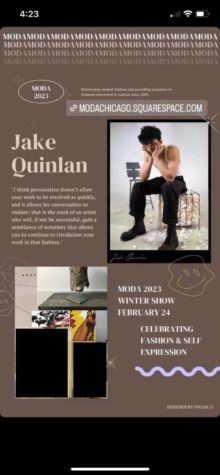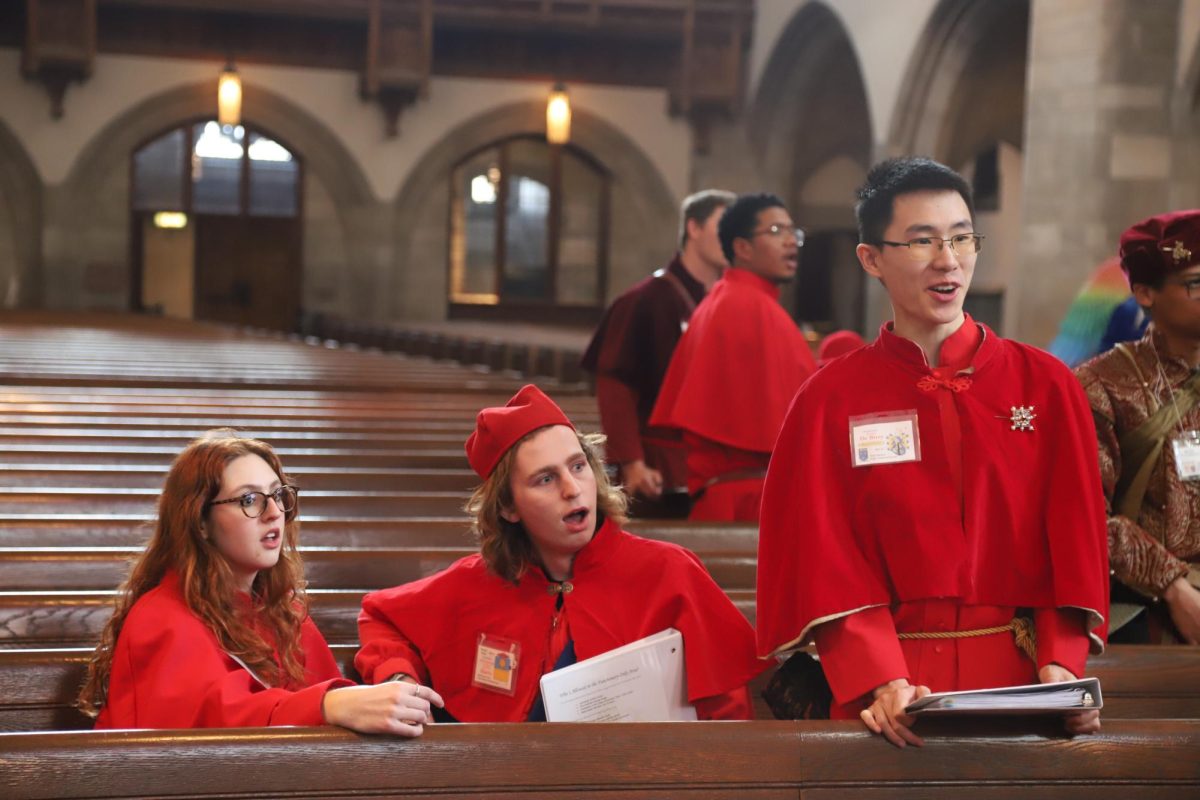Content warning: This article contains discussions of the sexual abuse, torture, deaths, and other human rights abuses which occurred in the Abu Ghraib prison.
Following social media backlash, a former designer at MODA, a fashion design–focused RSO, has apologized for including images of torture victims from Iraq’s Abu Ghraib prison in a “mood board” about his winter fashion collection posted February 24 on MODA’s blog.
Second-year Jake Quinlan’s designs prompted a series of apologies from various branches of MODA, which comprises a blog, magazine, and board that organizes an annual fashion show. Quinlan, who has since been dismissed from MODA, also apologized for his designs in a statement to The Maroon.
“In my intellectualization and abstraction of subjects of violence I am fully aware I have inadvertently contributed to their marginalization. I take full responsibility for my failings and apologize for the distress I have caused through my attempted use of the collectivist MODA platform,” Quinlan wrote in an apology statement emailed to The Maroon. “This is a very public failing of my social, moral, and ethical obligations as an artist to consider the entire context of my work, and I apologize to all those who have been harmed.”

The situation centered around a profile of Quinlan published on February 24 on MODA’s blog, which featured a “mood board” that contained two photographs depicting the torture of detainees at Iraq’s Abu Ghraib prison. The inclusion of the images in a piece meant to depict the designer’s inspiration for his collection sparked widespread controversy on campus and on social media. Quinlan’s collection did not debut at the MODA Winter Fashion Show as had been planned.
According to Quinlan, he decided to pull his collection from the Winter Fashion Show; he told The Maroon that “it was for the concern that vocal detractors would not be able to meaningfully differentiate between the models as a medium versus the models as individuals.” However, according to two independent sources who are members of MODA and were present at the show, the majority of the models assigned to wear Quinlan’s designs refused to walk the runway, effectively forcing him to pull his collection.
The “designer profile” on MODA’s blog included a transcript of an interview with Quinlan in which he said, “I think provocation doesn’t allow your work to be resolved as quickly, and it allows for conversation to endure; that is the mark of an artist who will, if not be successful, gain a semblance of notoriety that allows you to continue to circulation [sic] your work in that fashion.” The profile has since been deleted.
Abu Ghraib Prison
Located outside of Baghdad, Iraq, the Abu Ghraib prison was the site of numerous human rights violations perpetrated by the Central Intelligence Agency and the U.S. Military during the early stages of the Iraq War, which lasted from 2003 to 2011. Those violations included the physical and sexual abuse, torture, rape, and murder of prisoners.
Abu Ghraib became the subject of international outrage when reports and photographs of the torture and deaths from within the prison surfaced in 2004. One of the photographs used in Quinlan’s profile shows Ali Shallal al-Qaisi, who was imprisoned at Abu Ghraib in 2003. It is one of the most widely circulated images of the torture and was featured on the cover of The Economist in 2004.
Social Media Backlash
The profile’s appearance on the story of the @modachicago Instagram account triggered an immediate and widespread response on Twitter and Instagram. A tweet posted at 3:41 p.m. on February 24 by user @borzoinga calling out the incident garnered more than 115,000 views in its first 24 hours online.
Third-year Hala Hersi made numerous posts on social media criticizing MODA’s actions and response.
“The Iraqi POW at Abu Ghraib were put through horrific abuses at the hands of the U.S. Military that were indescribable,” Hersi told The Maroon. “For Jake Quinlan to use images of the Abu Ghraib victims in his work while also stating that ‘I think provocation doesn’t allow your work to be resolved as quickly’ is incredibly disrespectful and perpetuates a legacy of dehumanizing the suffering of Muslims and Brown people.”
“Had his goal really been to facilitate discussion, he would not have centered this work around himself and actually have considered the impacts using these images would have,” Hersi continued.
The Aftermath
MODA removed Quinlan’s profile Friday evening, a few hours after it was posted, and released a statement apologizing for “the lack of attention given to the content posted on February 24, 2023.” In the statement, which was updated at least three times as of this article’s publication, MODA blog editors-in-chief Vivian Li and Matthew Sumera wrote, “[T]here was a picture that wrongly glamorized the abuses that took place at Abu Ghraib, which we failed to recognize before publishing.”
The initial paragraph was updated to include Quinlan’s name and the date of publication for his profile. A second paragraph regarding the involvement of the editors was added to emphasize that the editors “[did] not have control over anything other than website content” and were in discussion with the MODA board regarding further actions.
The paragraph was then edited again to say instead: “After recent posting on the MODA Instagram, we would like to directly say that we, MODA Blog, do not support the artistic choices or the justification to objectify the suffering and torture that has happened in Abu Ghraib and that continues to occur.”
In response to The Maroon’s inquiry about the statement’s edits, Li and Sumera wrote: “[W]e were trying our best to get a statement out as soon as possible. At the same time, we were trying to determine how much should be said and how much clarification to give without a proper Board meeting. We were not at the show (Vivian was on a plane), so we did not fully understand what was occurring.”
“The Blog did not receive information on this collection from other branches and was unaware of the context of Jake’s collection besides talks of it being provocative and trying to be ‘avant garde,’” Li and Sumera told The Maroon over email.
The @modachicago Instagram account also posted a statement on its story from Quinlan regarding the inclusion of the Abu Ghraib photographs on his profile.
“High art and fashion have often been criticized for perpetuating exclusion, exploitation, and violence against marginalized groups. The following collection brings this conversation of exploitation to the runway. Sensitive themes are addressed in an effort to facilitate discussion and consideration, not aestheticize, promote, or glorify the long-standing suffering marginalized groups have endured under the veneer of fashion,” the statement read.
Li and Sumera criticized Quinlan’s artist statement in their comment to The Maroon. “As past designers ourselves, we do not support Jake’s artist statement and think it’s completely unjustifiable, and we did not appreciate it being posted on MODA’s Instagram.”
According to MODA’s three design directors, Sahana Gopalan, Kristin Wu, and William Hu, “Concerns were brought to the Board by a model about one specific look in [Quinlan’s] collection a few weeks ago, but not through us and not about the collection as a whole or the hurtful and offensive inspirations behind it. Our Presidents agreed to meet with Jake and review the collection. We were told the situation had been resolved when we followed up.”
In response to an inquiry made by The Maroon, MODA’s three design directors also clarified their role in reviewing Quinlan’s project: “Ultimately, it is the responsibility of the board to ensure the show as a safe place for creative expression. […] regular designers have historically been invited back each year without any competitive selection, and most of the application is optional. Ideas also change throughout the year, so these submissions are considered preliminary and many designers change their concepts/their sketches throughout the year.”
“Returning designers can also choose to do check-ins more infrequently—Jake opted for monthly check-ins where we were told he was completed with his sewing without proper emphasis on content. We take responsibility for this lack of a structured screening process and lack of scrutiny of our returning designers. The design directors are the first line of defense for prevention of these situations and we failed that mission this year. We will not allow that to happen again,” wrote the three design directors.
The design directors also outlined their plans moving forward. “From our end, we are developing meticulous procedures to ensure there is a standard method of prevention and a comprehensive review of anything that walks the runway. This entails returning designers overtly describing the inspirations of their designs, intended messages and themes each year. We will also standardize check-in processes to ensure all directors in the future place high emphasis on visual updates from designers.”
In their comment, the design directors told The Maroon that “Jake has been removed from MODA and will not be involved with this RSO in the future. We absolutely do not stand for any of these ideals and sincerely apologize to the models, designers, volunteers, and attendees who were affected by this incident.”
The editors-in-chief of MODA’s magazine, Grace Feeley and Caitlin Ellithorpe, responding to The Maroon’s inquiry about the controversy, described the three-pronged organizational structure of MODA: “There is a large split in responsibilities between the three magazine, blog, and board divisions. The magazine operates independently from the board and blog. We have no authority in planning the show or choosing and managing designers and models.”
“On behalf of the magazine, we do not condone the aestheticization or romanticization of violence. As a student fashion production, we understand MODA has a large platform with which to engage with the student body and showcase student creativity. We do not believe, however, that MODA is the place to amplify intentionally harmful, insensitive, and exploitative messages. On behalf of the entire organization, we apologize for the harm that this event has caused and are appalled by the circumstances that allowed this inappropriate display,” Feeley and Ellithorpe told The Maroon.
When reached for comment, MODA Co-Presidents Isabella Park and Gwyneth Howell directed The Maroon to the Board’s official statement, released on Instagram on Sunday, February 26. “This incident was the result of a lack of comprehensive screening and cross-referencing within several subsets of the Board,” the statement reads. “We would like to emphasize that MODA values creative expression, and in preparation of the show we wanted to avoid censorship of all designers. We failed to recognize that this collection was not appropriate for the MODA Show.”
“We want to apologize for the lack of oversight that led to these occurrences. We further acknowledge that the proliferation of insensitive images and notion of violence and Abu Ghraib has caused harm and discomfort to members of the greater UChicago community,” the statement concludes.
The full text of Jake Quinlan’s apology can be found here.
The full text of Vivian Li and Matthew Sumera’s statement can be found here.
The full text of Caitlin Ellithorpe and Grace Feeley’s statement to The Maroon can be found here.
The uncensored version of Quinlan’s design profile cover photo as posted by @modachicago, as well as a statement from Quinlan as posted by @modachicago, can be found here.













